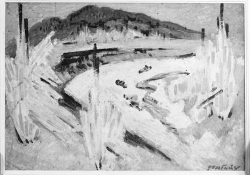Writing beyond English: The Challenges of Inventing Non-English Worlds in English-Language Novels

I write novels set in South India. In English, I invent characters shaped by other languages, primarily Tamil, but also sometimes Hindi. Many of my characters don’t just not speak English, they don’t think or feel English; which is to say, their interiority, the infinite and often occult world of their minds and hearts, is not English. Of course, neither the speech of my characters nor their interiority can be seen as separate from their society and their history. To imagine my non-English-speaking characters in English I must translate not just their speech—their dialogue—but entire worlds, internal and external.
Translate is simply shorthand. Writing a novel in English about a Tamil world may involve actual translation—of a real or imagined piece of Tamil text, for example—but the writing of the novel is not in itself translation except in the most metaphorical of senses. We should rigorously distinguish writing a novel in English about a Tamil world from translating a Tamil novel into English. Why? Because, if the aesthetic integrity of the novel is to be maintained, the novel has to be invented in/through English, not Tamil. You have to invent, in English, Tamil speech, feeling, action, philosophy, faith, family, friendship, hostility, love, work, and all the other things that go into the making of a world. You invent in English a Tamil world. Certainly, you can learn from translation how to go about this invention—as I did when I translated Komal Swaminathan’s great Tamil play Thaneer, Thaneer into English—but invention is not the same as translation because at its bottom, as I have written elsewhere, translation is interpretation of a prior text.
You have to invent, in English, Tamil speech, feeling, action, philosophy, faith, family, friendship, hostility, love, work, and all the other things that go into the making of a world.
Invention is not this kind of interpretation. So something mysterious has to happen: you have to find within English the wherewithal to depict a Tamil world. Language itself is your ally here; it is itself a resource. I don’t mean by this the capability of a specific language such as English or Tamil but rather the generative power inherent in all languages as language. Philosophers of language like Walter Benjamin and literary theorists like Gayatri Spivak have spoken of this power, which is the power of a language to transcend its own specific historical location. The English-language novelist confronted by the challenges of creating a non-English world needs to discover and access this power.
Alongside language, genre is at issue. How should we classify novels in English extensively populated with non-English-speaking characters? Writing fiction in English about communities that don’t function in English raises such specific challenges of craft and ethics that we should really think of such fiction as a genre unto itself. Neither scholarly criticism nor creative writing has sufficiently acknowledged this obvious notion because the challenges attending the writing of such fiction are still inadequately understood.
Recently, criticism has spent substantial energy in a historical and theoretical mode on exploring postcolonial literature written in English. This literature more often than not depicts non-English-speaking communities. Criticism has had interesting things to say about this literature. However, it has, in a manner typical of criticism in general, remained oblivious to questions of craft and technique.
 For its part, creative writing pedagogy has not fully acknowledged the peculiar difficulties of creating realistic non-English-speaking communities in English. At most, these difficulties are addressed in the writing of dialogue. Would such a character speak in quite this fashion? is a question sometimes posed in a creative writing context. Certainly, such questions put needed pressure on dialogue as the external mark of a character’s authentic interiority. However, the challenges of inventing a non-English-speaking world in English through the tools and rules of the novel go beyond dialogue. They include narrative voice. For ethical and political reasons, my concern throughout my most recent novel, Ghost in the Tamarind, is to tell the story in a way internal to the narrative—that is, to imagine and narrate the Tamil world of the novel from the perspective of someone who is an integral part of that world (though perhaps critical of it). The craft challenges of telling a story from the point of view of such a narrator in an English-language novel should not be underestimated.
For its part, creative writing pedagogy has not fully acknowledged the peculiar difficulties of creating realistic non-English-speaking communities in English. At most, these difficulties are addressed in the writing of dialogue. Would such a character speak in quite this fashion? is a question sometimes posed in a creative writing context. Certainly, such questions put needed pressure on dialogue as the external mark of a character’s authentic interiority. However, the challenges of inventing a non-English-speaking world in English through the tools and rules of the novel go beyond dialogue. They include narrative voice. For ethical and political reasons, my concern throughout my most recent novel, Ghost in the Tamarind, is to tell the story in a way internal to the narrative—that is, to imagine and narrate the Tamil world of the novel from the perspective of someone who is an integral part of that world (though perhaps critical of it). The craft challenges of telling a story from the point of view of such a narrator in an English-language novel should not be underestimated.
Writing in English about non-English-speaking communities raises issues of craft (dialogue, characterization, and narrative voice) that are unavoidably linked to ethics and politics. Take, for example, caste and its history, central to my novel. The terminology of caste is anything but straightforward and is especially fraught when it comes to inventing a fictional world with some political and ethical stakes. Caste labels in India have undergone radical transformation throughout the twentieth century in response to social changes and political mobilizations. The group of castes once referred to as achut or “untouchable” is now referred to as Dalit. Between when they were called “untouchable” and now, when they are called Dalit, this group has been known in Tamil by a number of other names—Adi Dravidar, scheduled caste, Harijan, to name the most common. Some of these names remain in circulation still, even as Dalit has become the preferred and most common name.
This change in terminology is also evident at a more micro level. Particular caste names too have undergone changes. Because of pejorative associations, some castes have discarded old names and taken new ones. In other cases, the way a particular caste name is written has changed. Where formerly the name might commonly have been written in a “low” and familiar form (for example, Paraiyan), now the name, when used at all, is written in a more honorific way (Paraiyar) as other “higher” caste names have been routinely.
The ramifications of the history of caste and anticaste struggle are many when it comes to the composition in English of a fictional world that is Tamil. The first question in this regard has to do with what caste term to use. Should you allow a character to use a term that you know is demeaning and hurtful in the present context but which would have been natural within the setting of the story?
Writing in English about non-English-speaking communities raises issues of craft (dialogue, characterization, and narrative voice) that are unavoidably linked to ethics and politics.
The question is not an easy one to answer, but one—my preferred—option is to introduce a contested term within a narrative situation that allows the usage to be explored or challenged. Octavia Butler does just this in Kindred, her brilliant novel about slavery. In Ghost in the Tamarind, I try to do it in a brief dialogue set in the late 1930s when the protagonists, the Brahmin Ramu and the Dalit Ponni, are yet adolescents:
Ramu held out the book in response, but Ponni only looked at him distrustfully. She made no attempt to take the book from him. “I did not think you would come,” she said. “I did not think you would bring the book.”
“Why?” he asked, surprised.
“Just a thought.”
“You thought I wouldn’t come because of who you are.”
“My uncle says we should call ourselves Adi Dravidar.”
“Adi Dravidar . . . ?”
“Yes.”
“Not Harijan?”
“No.” She made a dismissive clucking sound. “That’s Gandhi’s term.” (74)
Thus, through the creation of a scene involving already established characters, terms are introduced and debated.
In my experience it is easier to find solutions in the realm of dialogue and characterization to the challenges of inventing non-English worlds in English. A well-written character provides a reader with a lot of information for judgment. For example, as readers we would expect a villainous character to be villainous in speech as well as behavior. In this way, characterization can aid a writer in alerting a reader who lacks the requisite knowledge to the specificities of certain usages.
So much for characterization, but what of narrative voice, mentioned above? Generally, the greater challenge has to do not with characters and dialogue but rather with narrative voice. I am thinking, for example, of a narrative voice that is meant simply to be Tamil though it is written in English. The evocation in English of a non-English voice—of a narrative voice that might be presented in English on the page but is not of an English-speaking world—is not a simple matter.
Occasionally novelists writing in English about non-English-speaking communities have acknowledged the challenge of this enterprise, as Raja Rao did virtually at the start of the literary tradition of anglophone novels in India. He declared in the much-cited preface to his 1938 novel Kanthapura that his English could not sound like the English of British or American writers. He meant by this declaration to identify the difficulty of inventing in English the voice of his elderly Kannada-speaking female narrator. We may debate whether Rao succeeds, whether his language does not succumb to a kind of exoticization, but I don’t believe the urgency of the challenge identified by him can be dismissed.
The great African writer Chinua Achebe is also exemplary here. It’s almost a cliché to cite Things Fall Apart in this regard. Achebe not only bent English to Igbo idiom, but he illustrated the political consequences of narrative voice by replacing in the final chapter one narrative voice—a voice internal to Igbo society that until then has governed the narration in the novel—with the alien voice of the British district commissioner. As the alien voice takes over the narration, everything changes—the language, of course, but also the very world into which the reader is invited. This world is no longer Igbo; it is the world of the colonial masters.
These are some hints concerning the complexities of narrating non-English worlds in English. Such narration is especially a challenge in a novel that adopts a narrative voice which knows all that needs to be known about the fictional world, including its past and future. In such a novel, should the writer—anachronistically—use contemporary, and perhaps politically and ethically more acceptable, words in creating a world far in the past? Should the writer mark for the reader the difference in Tamil between a familiar, even demeaning title and an honorific one? A Tamil readership would immediately recognize the difference. A readership ignorant of Tamil would not. How important is it to provide such an audience with the knowledge it lacks? Surely, many of these difficulties would exist in a Tamil novel about a Tamil world (as they do in Kindred, an English-language novel about an English-speaking world), but they are compounded in an English-language novel about a Tamil world.
Should the writer—anachronistically—use contemporary, and perhaps politically and ethically more acceptable, words in creating a world far in the past?
Ghost in the Tamarind is deeply invested in the politics of anticaste radicalism. At the same time it tries to take seriously the aesthetic challenges of creating in English a Tamil world that has autonomy and historical depth. Late in Ghost in the Tamarind, Ramu and Ponni, whom we encountered in the previous passage as adolescents, set up a rural school with their friend Arokiasamy. The time is the 1960s, and their intention is to educate the socially deprived. Inevitably, their aspirations bring the school under attack. In a passage, the school and the threat are presented:
The school compound is tidy if small. Most of the space within the fence is taken up by the two thatch-roofed classrooms with mud walls, the rough brick office structure, and the playground. The playground has a small sandbox that Ponni uses to teach the youngest children the alphabet the old-fashioned way, by drawing figures in the sand with a twig and having the children trace them—௮, ஆ, இ, ஈ, and so on. The vowels first, then the consonants. A mango tree casts welcome shade over the playground. In one corner of the school compound, two coconut trees lean against a sky bleached white by a fiery sun.
“This stick,” Ramu says, gesturing to the stout weapon in Karuppan’s hands. “Is it necessary?”
“You don’t know, Teacher-Sar,” Karuppan replies. “Anything is possible. You have to be prepared for anything.” Because Karuppan was once a student at the school, when he calls Ramu Teacher-Sar and Ponni Teacher-Amma, he’s not using the terms only as honorifics as most villagers do. After all, he really was a student of theirs, and of Arokiasamy too. Ramu remembers well the wide-eyed boy with knobbly knees and a restless hunger for learning. It enrages him to see the jackals in human clothing circling now, plotting to bring him down so as to get at the school. (249)
Does this passage depict a Tamil world in the English language? I’ll let the reader decide.
University of Hawai`i











